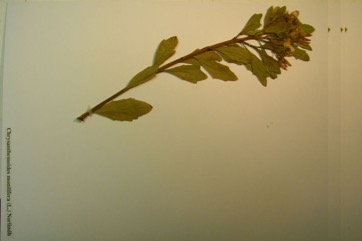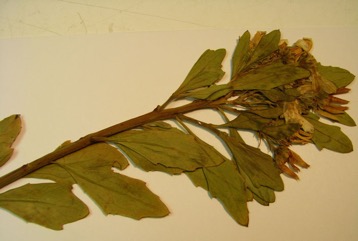Boneseed

It grows in warm temperate and subtropical locations. It grows in a range of locations. It can grow on coastal dunes and on the edges of evergreen forest. It can grow in dry sandy soils. It grows in warm temperate places. It can grow between 90-2,250 m above sea level. It grows in areas with an annual rainfall between 150-200 mm. It can grow in arid places. It suits hardiness zones 9-11. Tasmania Herbarium.
Also known as:
Bitou, Bush-tick berry, Itholonja, Jungleflower, Umtholombe
Synonyms
- Osteospermum moniliferum L.
- and others
Edible Portion
- Fruit
Where does Boneseed grow?
Found in: Africa, Australia, East Africa, Eswatini, France, Kenya, Lesotho, Lord Howe Island, Malawi, Mediterranean, Mozambique, New Zealand, South Africa, Southern Africa, St Helena, Swaziland, Tanzania, Tasmania, Zimbabwe
Notes: There are 2 Chrysanthemoides species. It is often regarded as a problem plant because it crowds out other plants. It is now a prohibited import into Australia. It can become invasive.
Status: The fruit are eaten especially by children.
Growing Boneseed
Cultivation: Plants can be grown from seed or cuttings.
Edible Uses: The fruit are sweet and palatable. They can be used for jam and also dried.
Production: It is a fast growing plant.
Nutrition Info
per 100g edible portion| Edible Part | Energy (kcal) | Protein (g) | Iron (mg) | Vitamin A (ug) | Vitamin c (mg) | Zinc (mg) | % Water |
|---|---|---|---|---|---|---|---|
| - | - | - | - | - | - |
Boneseed Photos


References
Bodkin, F., 1991, Encyclopedia Botanica. Cornstalk publishing, p 255
Breidahl H., 1997, Australian Southern Shores. Lothian. p 80
Cameron, M., (Ed.) 1981, A Guide to Flowers & Plants of Tasmania. Reed p 92
Cundall, P., (ed.), 2004, Gardening Australia: flora: the gardener's bible. ABC Books. p 374
Cunningham, 1985,
Curtis, W.M., 1963, The Students Flora of Tasmania Vol 2 p 373
Dashorst, G.R.M., and Jessop, J.P., 1998, Plants of the Adelaide Plains & Hills. Botanic Gardens of Adelaide and State Herbarium. p 140
De Vynk, J. C., et al, 2016, Indigenous edible plant use by contemporary Khoe-San descendants of South Africa's Cape South Coast. South African Journal of Botany. 102 (2016) 60-69 (As Osteospermum moniliferum)
Etherington, K., & Imwold, D., (Eds), 2001, Botanica's Trees & Shrubs. The illustrated A-Z of over 8500 trees and shrubs. Random House, Australia. p 210
Flora of Australia Volume 49, Oceanic Islands 1, Australian Government Publishing Service, Canberra. (1994) p 397 subsp. rotundata
Fox, F. W. & Young, M. E. N., 1982, Food from the Veld. Delta Books. p 128
Lamp, C & Collet F., 1989, Field Guide to Weeds in Australia. Inkata Press. p 75
Lazarides, M. & Hince, B., 1993, Handbook of Economic Plants of Australia, CSIRO. p 59
Long, C., 2005, Swaziland's Flora - siSwati names and Uses http://www.sntc.org.sz/flora/
Lord, E.E., & Willis, J.H., 1999, Shrubs and Trees for Australian gardens. Lothian. p 215
Low, T., 1992, Bush Tucker. Australia’s Wild Food Harvest. Angus & Robertson. p 79
Marinelli, J. (Ed), 2004, Plant. DK. p 449
Paczkowska, G. & Chapman, A.R., 2000, The Western Australian Flora. A Descriptive Catalogue. Western Australian Herbarium. p 159
Palgrave, K.C., 1996, Trees of Southern Africa. Struik Publishers. p 913
Peters, C. R., O'Brien, E. M., and Drummond, R.B., 1992, Edible Wild plants of Sub-saharan Africa. Kew. p 89
Royal Botanic Gardens, Kew (1999). Survey of Economic Plants for Arid and Semi-Arid Lands (SEPASAL) database. Published on the Internet; http://www.rbgkew.org.uk/ceb/sepasal/internet [Accessed 11th April 2011]
Ruiters-Welcome, A. K., 2019, Food plants of southern Africa. Ph.D. thesis. Univ. of Johannesburg p 36
Svensk. Bot. Tidskr. 1:374. 1943 (Stud. Calenduleae)
Swaziland's Flora Database http://www.sntc.org.sz/flora (As subsp. canescens)
Tasmanian Herbarium Vascular Plants list p 6
Tredgold, M.H., 1986, Food Plants of Zimbabwe. Mambo Press. p 65
Van Wyck, B., & Van Wyck, P, 1997, Field Guide to Trees of Southern Africa. Struik. p 134
van Wyk, Be, & Gericke, N., 2007, People's plants. A Guide to Useful Plants of Southern Africa. Briza. p 36
van Wyk, B-E., 2011, The potential of South African plants in the development of new food and beverage products. South African Journal of Botany 77 (2011) 857–868
von Breitenbach, F., 1985, Southern Cape Tree Guide. Department of Environment Affairs, Forestry Branch. Pamphlet 360 Pretoria p 33
White, F., Dowsett-Lemaire, F. and Chapman, J. D., 2001, Evergreen Forest Flora of Malawi. Kew. p 202
Whiting, J. et al, 2004, Tasmania's Natural Flora. Tasmania's Natural Flora Editorial Committee PO Box 194, Ulverstone, Tasmania, Australia 7315 p 362
Williams, J.B., Harden, G.J., and McDonald, W.J.F., 1984, Trees and shrubs in rainforests of New South Wales and Southern Queensland. Univ. of New England, Armidale. p 70, 75, 98
World Checklist of Useful Plant Species 2020. Royal Botanic Gardens, Kew (As Osteospermum moniliferum)
Young, J., (Ed.), 2001, Botanica's Pocket Trees and Shrubs. Random House. p 245